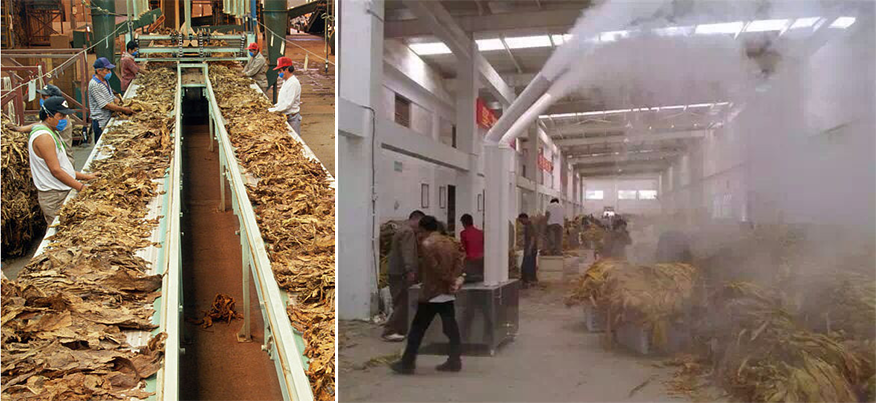
Tobacco industry
Water is one of the most important components of tobacco. Generally, fresh tobacco leaves have a very low moisture content after baking, generally around 5-8%. They are very easy to break, and they will become a pile of slag after a little force. Blocking the flue or directly drilling into the entrance will cause coughing and a burning sensation in the throat. At the same time, lack of water will cause the tobacco to burn too fast, and the high temperature will cause the tobacco taste to become frizzy and pungent; when the tobacco is too dry, the dry air will make the surface shrink, fragile, easy to tear, and cracks. Therefore, you must be very careful when handling tobacco. The tobacco leaves must absorb moisture and regenerate moisture so that the moisture content reaches between 14-16%RH. During the baking process, you must be careful and maintain the relative humidity of the surrounding environment to ensure the output of high-quality and mellow tobacco.
During the initial storage of tobacco, the tobacco needs to be transported to larger warehouses for storage. The relative humidity of these areas must be maintained at 60-70% RH, because the tobacco at this time is exposed to a wider environment. If the humidity is not maintained, the tobacco will dry out quickly.

In the cigarette production process, the cigarettes are transferred to the cigarette making machine through the compressed air pipe, and are wrapped in cigarette paper after entering the hopper. During this operation, the moisture content of the tobacco will change due to the operating speed of the machine and the ambient air and pressure. Generally, the production area of cigarettes needs to be maintained in an environment with a relative humidity of 65-68%. If the humidity is lower than about 60% RH, the tobacco will begin to become dry, causing the tobacco to fall from the cigarette. When the cigarette is finished, it will be transported to the sorter for subsequent packaging.
There is also a special link that requires humidification. In the process of tobacco recycling, the relative humidity must be maintained at 65% RH. Below this humidity, it will lead to poor tobacco recycling and cause loss of enterprises.
It can be seen that accurate temperature and humidity control is indispensable in the process of tobacco production. So, how should a company choose a suitable humidifier?
 In terms of model selection, companies can comprehensively consider factors such as site area, floor height, sealing degree, fresh air supply, site temperature and humidity status, and initial humidity target value. In terms of brands, you can choose brands with strong strength and years of experience in temperature and humidity control to provide services for enterprises.
In terms of model selection, companies can comprehensively consider factors such as site area, floor height, sealing degree, fresh air supply, site temperature and humidity status, and initial humidity target value. In terms of brands, you can choose brands with strong strength and years of experience in temperature and humidity control to provide services for enterprises.
At present, the most widely used humidifier in the tobacco industry is the ultrasonic humidifier. Due to the large amount of water mist generated by the ultrasonic humidifier, the atomization efficiency is high, and the diameter of the mist particles is only 1-5μ, the resulting humidification effect is more significant and complete. It can meet the humidity demand of today's tobacco industry.
In response to the needs of the tobacco industry, Dorosin has developed a series of ultrasonic humidifiers dedicated to the tobacco industry. This series uses the high-frequency resonance technology of the atomizer to throw water away from the water surface to produce natural water mist. It does not require heating or chemical agents to produce 1-5 micron water particles floating in the air to achieve air humidification. The humidification efficiency is close, and the fog particles produced are small and uniform. At the same time, it has its own water protection device and humidity digital automatic control, which does not require personnel and is simple to use.
Precise temperature and humidity control can ensure that tobacco, cigarette paper, and tobacco leaves maintain the required humidity level, prevent the loss of tobacco flavor, and reduce fertilizers, which not only guarantees the quality of the product, but also improves the yield.



